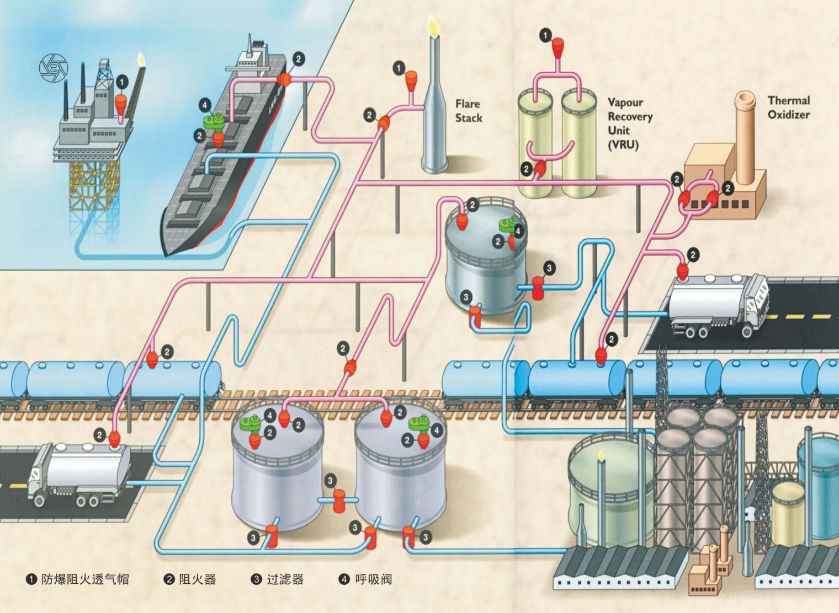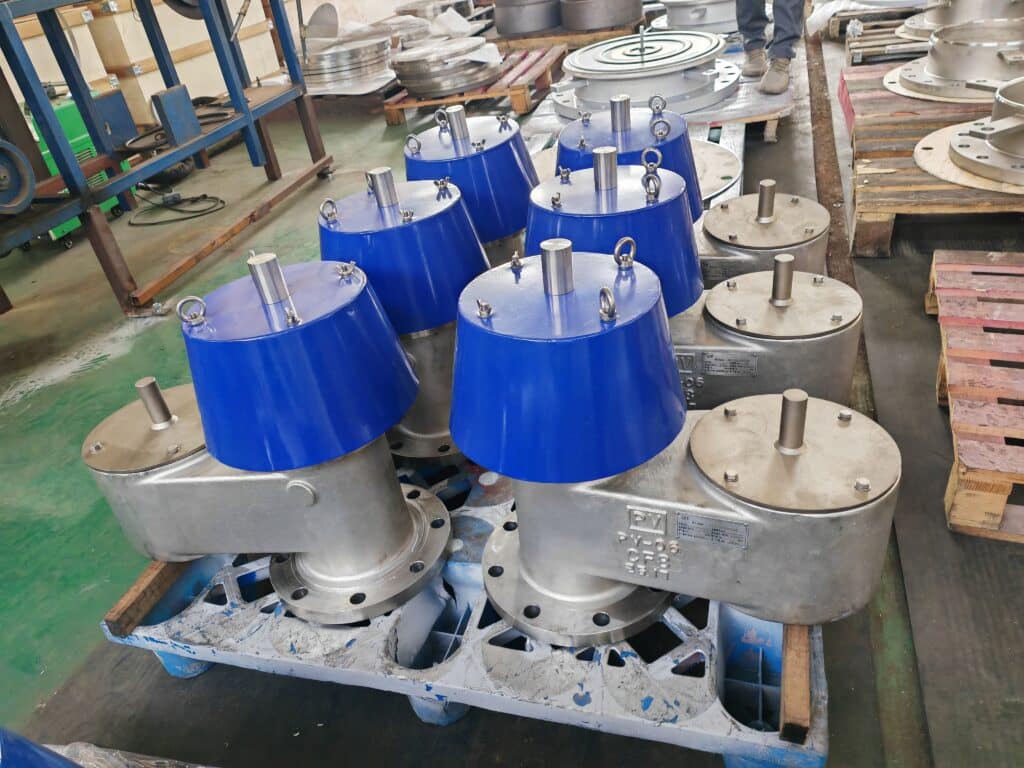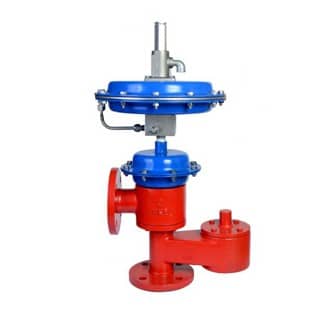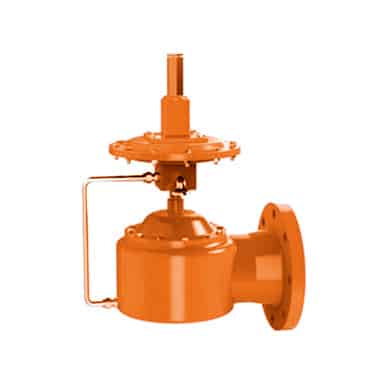In industrial storage tank applications, it is critical to select the right pressure and vacuum relief valves (PVRV) to ensure the safe operation of the tank. We recently received a question from a customer who ran into a typical problem when selecting a breather valve. This is a valuable case to share and discuss suitable solutions.

Project Background
This project involves a storage tank used for storing acetone with nitrogen gas used as an inert blanketing medium. The nitrogen is used to keep the oxygen in the air from coming into contact with the acetone, which reduces the potential fire risk. The storge tank is designed for a pressure of 180 mbarg (positive pressure) and -10 mbarg (negative pressure) to handle the various inflow and outflow conditions.
The breather valve’s discharge outlet is connected to a flare system that has a maximum back pressure of 65 mbarg, and the breather valve is set at 90 mbarg. However, the customer’s other breather valve supplier told him that because of the back pressure, the actual opening pressure of the valve would be 155 mbarg (90 + 65), which is way over what the process engineer designed for and could potentially overpressure the tank. Also they didn’t give any solution for the customer, that’s why customer find THINKTANK and ask for a solution.
Storgage Tank Design
- Positive Setting Pressure: 180 mbarg
- Negative Setting Pressure: Set -10 mbarg
Customer’s Problem
- Back pressure is caused by the breather valve discharge being connected to the flare line.
- The tank design conditions are 180 mbarg and -10 mbarg.
The problem is with the elevated set point because the breather valve vendor says the valve will relieve only at 155 mbar(90+65) rather than at 90 barg setpoint
Problem Analysis
The core issue here is the impact of back pressure. Traditional breather valve designs use weight or spring loading, and as back pressure increases, the actual opening pressure of the valve increases accordingly. Normally, there is no back pressure when the breather valve is discharged to the atmosphere, but in this project, due to the breather valve was connected to flare header, a back pressure outside the normal range was caused. This design does not allow the breather valve to work properly at the preset 90 mbarg.
In this case, the use of a traditional breather valve would cause the set point to rise beyond the design pressure of the tank, increasing the risk to the tank.

THINKTANK’s Solution
1. Reduce Back Pressure
We can reduce back pressure by increasing the pipe size, or the outlet port closer connect with flare system.
2. Select Correct Type of Breather Valve – Pilot Operated PVRV
For ordinary gravity or spring-loaded breather valves, if the setting value of 155 mbarg is followed by other suppliers, when the back pressure decreases (the back pressure range is 0~65mbarg), a higher opening pressure problem may occur. For example, if the back pressure drops to 10mbarg, the opening pressure will be 155-10=145mbarg, which will exceed the safety setting value of the tank. The breather valve must be set at a 90 mbarg pressure relief value, and the risk to the tank will be greatly increased.
It is recommended to use a pilot-operated pressure relief vacuum valve, so that pressure relief can be started at the 90 mbarg set point under different back pressure conditions.

Why to Use Pilot Operated Pressure/Vacuum Relief Valve
The reason why the pilot-operated pressure vacuum relief valve (POPVRV) can prevent the main valve from being affected by backpressure is due to its special design. The main valve is not affected by backpressure because the pilot valve controls the main valve’s operation. The opening and closing of the valve is isolated from the tank pressure or external backpressure by the pilot valve.

1. Independent Opening Mechanism from Backpressure
Traditional weight-loaded or spring-loaded breather valves depend on the physical weight of the valve disc or the spring force. When backpressure increases, the total pressure required to open the valve increases as well. This means that in cases of significant backpressure, the actual opening pressure of the valve will be higher than the set point. On the other hand, a pilot-operated PVRV uses a separate control chamber to control the valve’s opening. This ensures that the opening pressure is only affected by the set point and not by changes in backpressure.
Pilot Operated Pressure /Vacuum Relief Valve Working Principle
The pilot valve is a small valve that controls the operation of the main valve. When the pressure or vacuum inside the tank reaches the set point, the pilot valve opens, which releases the pressure or vacuum in the main valve’s chamber, causing the main valve to open. This design ensures that the main valve opens exactly at the set pressure without any delay due to variations in backpressure.
2. Lower Overpressure
Ordinary weight-loaded or spring-loaded PVRVs require significant overpressure (above the set pressure) to fully open the valve, which in some cases can bring the tank pressure close to the design limit. But the pilot-operated PVRV can begin to open and fully operate with lower overpressure, typically requiring only 10% to 15% overpressure to achieve full flow. This reduces pressure fluctuations inside the tank and enhances the safety of the equipment.
3. Precise Pressure Control
Pilot-operated PVRVs give you better control over the pressure and vacuum set points for your tank. Regardless of external backpressure, the pilot operated breather valve can keep the main valve closed until the internal pressure reaches the set point. This avoids problems such as premature or delayed opening due to superimposed backpressure, ensuring safe operation of the tank under the intended pressure conditions.
4. Efficient Sealing
One advantage of the pilot-operated PVRV design is that it can maintain good sealing performance as it approaches the set pressure, preventing gas leakage. For example, by using special sealing technology (such as air-cushioned sealing), the valve can stay sealed even when it’s near the set pressure, which prevents premature gas leaks, reduces product loss, and prevents environmental pollution.
5. Flexible Adaptability
Pilot-operated PVRVs can be configured to meet different pressure ranges and operating conditions as needed. For example, you can customize the pressure set point and response time of the pilot valve based on your specific tank needs. You can even use them in systems with fluctuating backpressure, such as tanks connected to flare systems.
Conclusion
When selecting a suitable breather valve for storage tank applications, it is important to not only consider the system’s design pressure but also fully account for the impact of back pressure. The pilot-operated pressure/vacuum relief valve (POPVRV) has significant advantages in dealing with back pressure issues and ensuring safe operation under varying back pressure conditions. However, engineers must also consider the risks associated with back pressure fluctuations when selecting a POPVRV and take the necessary precautions, such as lowering the set pressure, using a back pressure control system, and installing a monitoring system.
With this type of design and protection, you can effectively avoid the risk of tank overpressure due to back pressure fluctuations, ensuring the safety and stability of your tank throughout its operation.
If you need more information on pilot-operated breather valves or other tank protection equipment, feel free to visit our website to download product catalogs or contact us directly. We look forward to collaborating with you to provide the best solutions for your project.






